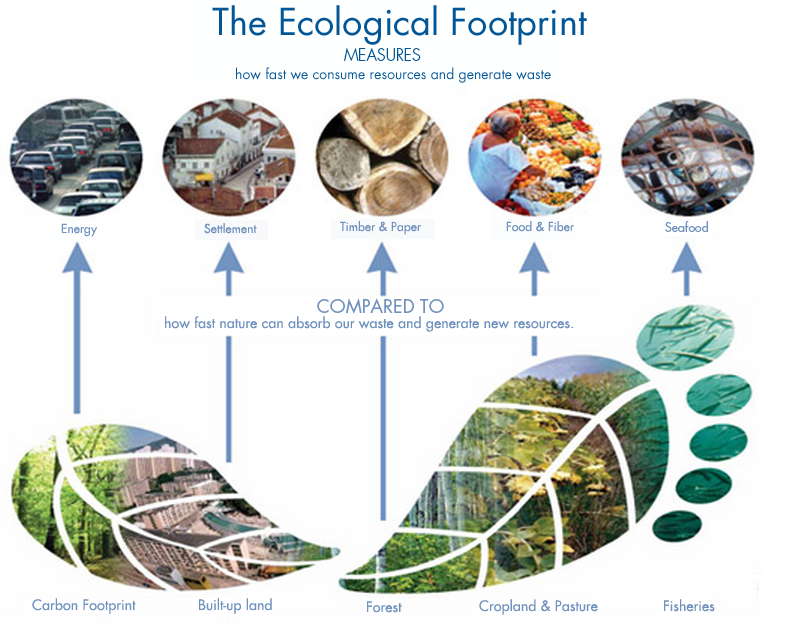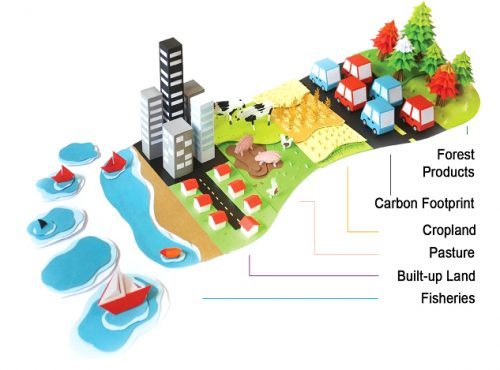Describe the Concept of an Ecological Footprint
For a certain population or activity EFs measure the amount of productive land and water required for the production of goods and the assimilation of. An ecological footprint measures our impact on the environment represented in the amount of land and natural resources that are used to meet our demands.

Remember Ecological Footprints Ecological Footprint Ecology Footprint
Ecological Footprints EFs are an assessment of humanities dependence on natural resources.

. An impression of the foot on a surface. The concept of footprint originates from the idea of ecological footprint - EF Fang et al 2014 introduced by Rees 1992. The United States has more than six times the per capita ecological footprint of China USA.
It calculates our impact to our environment. The effect that a person company activity etc. In other words these are the things we do that deplete our natural resources like overconsumption pollution or simply being greedy without thinking about the survival of the next generation.
An ecological footprint is a measure of the pressure that humans exert on the planet. Also referred to as an ecological footprint this is a measure that attempts to consider multiple impacts of an. View the full answer.
An ecological footprint is the measurement system that helps us calculate the human pressurethe human demand on Earth s ecosystemsIt calculates what percentage and part of the world we use individually or in groups. How the Footprint Works. The ecological footprint is a method promoted by the Global Footprint Network to measure human demand on natural capital ie.
On the demand side the Ecological Footprint adds up all the productive areas for which a population a person or a product competes. 98 vs China 16. As a model it is able to provide a quantitative estimate of human carrying capacity.
It refers to the area required to sustainably support a given population rather than the population that a given area. Use the ecological footprint concept to explain how we are living unsustainably. We review their content and use your feedback to keep the quality high.
It would take a full Earth and a half to produce the amount of resources needed to meet current human demandtwo Earths by the year 2050. It has become one of the most widely used measures of humanitys effect upon the environment and has been used to highlight both the apparent unsustainability of current practices and the inequalities in resource consumption between and within countries. It measures the ecological assets that a given population or product requires to produce the natural resources it consumes including plant.
The Ecological Footprint definition is simply a way to measure how much we use and consume in relation to our environments capacity to provide and support our needs. The area on a surface covered by something. Similarly the ecological footprint EF represents the area of land on earth that provides for resources consumed and that assimilates the waste produced by a given entity or region.
The ecological footprint is a method of gauging humans dependence on natural resources by calculating how much of the environment is needed to sustain a particular lifestyle. One of the primary sources of global energy is fossil fuels. After its introduction several other environmental footprints have been introduced.
The term ecological footprint was developed by environmentalists to describe the impact that an individual has on his or her environment. Ecological footprint EF measure of the demands made by a person or group of people on global natural resources. However the United States total ecological footprint 2810 million hectares is only slightly larger than Chinas 2050 million hectares.
The simplest way to define ecological footprint would be to call it the impact of human activities measured in terms of the area of biologically productive land and water required to produce the goods consumed and to assimilate the wastes generated. An ecological footprint is a tool for measuring the demand placed on nature. An ecological footprint takes a number of things into account such as car ownership amount of garbage generated how often the individual walks or rides a bicycle and other things designed to gauge land and water usage.
The quantity of nature it takes to support people or an economy. Ecological Footprint accounting measures the demand on and supply of nature. The accounts contrast the biologically productive area people use for their consumption to the biologically productive.
Much of this demand comes from energy usage. The Cambridge dictionary defines environmental footprint as. The personal ecological footprint refers to the demand for ecological resources and services that an individual takes from nature to fulfill their needs support other people and the economy.
The concept of a personal ecological footprint. The term Environmental Footprint also known as Ecological Footprint refers to the long-term negative impacts of human activities on the natural environment. The Merriam-Webster Dictionary defines footprint as.
The concept of an ecological footprint like the more familiar carbon footprint attempts to estimate how much of the global resources individuals use to sustain their lifestyles. It tracks this demand through an ecological accounting system. Footprints are divided into environmental economic and social footprints and combined environmental social andor economic footprints Čuček et al 2012c.
Widely used by scientists businesses governments agencies civil society organisations and individuals working to monitor ecological resource use and advance sustainability the ecological footprint EF represents the amount of land and water area needed to produce the resources an individual population or activity consumes and to absorb and render harmless the. On the demand side the Ecological Footprint measures an individual or a populations demand for plant-based food and fiber products livestock and fish products timber and other forest products space for urban infrastructure and forest to absorb its carbon dioxide emissions from fossil fuels. In scale from personal shelter to neighborhoods to the large-scale civic surroundingsThe term is widely used to describe the interdisciplinary field of study.
It is expressed in global hectares gha or by number of planets and it allows us to estimate the land surface needed by each individual to provide for their needs. The ecological footprint of a population is the area of land in the same vicinity as the population that would be required to provide all the populations resources and assimilate all its wastes. From the data gathered by several agencies it seems that we are now over using our finite resources.
Has on the environment for example the amount of natural resources that they use and the amount of harmful gases that they produce.

Ecological Footprint Global Footprint Network

What Is The Ecological Footprint Earth Overshoot Day

Major Components Of The Ecological Footprint Graphic By Imola Kocsis Download Scientific Diagram

The Ecological Footprint Is A Measure Of The Load Imposed By A Person Download Scientific Diagram
0 Response to "Describe the Concept of an Ecological Footprint"
Post a Comment